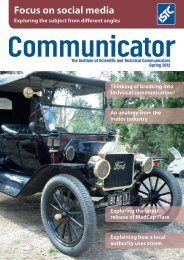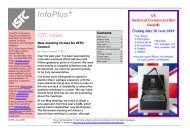S1000D-compliant illustrations - ISTC
S1000D-compliant illustrations - ISTC
S1000D-compliant illustrations - ISTC
You also want an ePaper? Increase the reach of your titles
YUMPU automatically turns print PDFs into web optimized ePapers that Google loves.
18 Project profile<br />
Fruit and vegetables: a winning entry<br />
‘What on earth do you do in a supermarket?’ Pam Nicholl describes<br />
her work as a technical communicator in a retail environment.<br />
‘…a new manager is<br />
far better equipped to<br />
maintain consistency<br />
if all our policies<br />
and procedures are<br />
clearly expressed in<br />
writing…’<br />
As an integral part of our drive for continuous<br />
improvement, the <strong>ISTC</strong>’s 2005 Documentation<br />
Awards became the Branch Operating Procedures<br />
(BOP) team’s project for last year. For me, it<br />
presented a time to reflect that my career<br />
development in Waitrose has really been one long<br />
project in itself. It has been challenging, very<br />
hard work, lively, innovative and vibrant. There<br />
is always a new challenge, always the need to<br />
identify, improve, simplify, satisfy and move on.<br />
The beginning<br />
I joined Waitrose as a Management Trainee with<br />
the intention of working my way up to branch<br />
management. The business was well organised and<br />
branch systems and processes worked smoothly,<br />
but very little was written down, apart from the<br />
financial and stock management elements of<br />
the operation. At that time, we were no different<br />
from any other retailer in this respect. However,<br />
more managers were being recruited as graduate<br />
trainees or from other industries and competition<br />
among supermarkets was, and still is, fierce.<br />
It seems evident that, in a company where<br />
standards are of paramount importance, a new<br />
manager is far better equipped to maintain<br />
consistency if all our policies and procedures<br />
are clearly expressed in writing and that they<br />
should be available for all branch Partners to<br />
refer to, rather than management alone.<br />
These observations must have been well<br />
timed. A year into my first branch appointment<br />
I was asked how I would like to move to head<br />
Pam Nicholl with Mark Andre, Department Manager Merchandise at Wokingham<br />
office for 12 months to ‘bring the procedures up<br />
to date’. This seemed an exciting challenge well<br />
worth taking up.<br />
A time of change<br />
I achieved my one-year deadline, but along the<br />
way I discovered I was on a mission. At our head<br />
office in Bracknell, department structures were<br />
changing. As branches increased in number, it<br />
was no longer practical to have regular visits<br />
from subject experts who contributed to the<br />
education process. It was going to become<br />
increasingly important to have all the elements<br />
of operational procedure clearly formulated to<br />
deliver change and evaluate its impact as we<br />
moved into the future.<br />
It was also becoming clear that technical<br />
advances in our operating systems would raise<br />
the need for user guides and that, as legislation<br />
placed more demands on food retail, records and<br />
documentary evidence would need to become<br />
part of the daily routine. In fact, enforcement<br />
officers would soon be insisting on it. As is very<br />
likely the case in most companies, it was not<br />
always easy at first to convince colleagues of a<br />
need that had not yet strictly arisen.<br />
The long-term project<br />
Thus, my long-term project began as Procedures<br />
Coordinator. This was quite a good description<br />
of the role at the time and consisted of getting<br />
to know department heads, understand their<br />
roles and interaction with our branches,<br />
and then move on to identify which further<br />
aspects of the branch operation needed to be<br />
documented and to what level of detail.<br />
Having no background in this field but being<br />
a logical thinker and lapsed translator, I decided<br />
to begin by attending a two-day course on<br />
policy and procedures. This gave me a good,<br />
clear picture of where I felt we should be. I<br />
started identifying those components of the<br />
branch operation that were not documented or<br />
were poorly understood, and worked out a new<br />
structure to demonstrate how it could work.<br />
After establishing contact with the various<br />
subject experts at head office, I visited a number<br />
of branch managers to identify what might help<br />
them to do their job better. Some highlighted<br />
the need for more detailed procedures and some<br />
quite the opposite. It was interesting to discover<br />
what was custom and practice and what was<br />
actual company policy.<br />
As a relative newcomer, I was able to ask<br />
without embarrassment any question that came<br />
to mind because there was no expectation that<br />
Communicator Spring 2006






